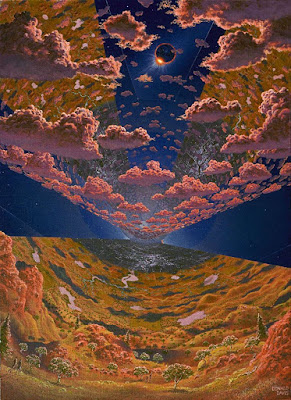 |
| NASA artist Don Davis gave us a vision of how it might look inside an O'Neill cylinder with reflected sunlight. |
I needed a space-based habitat that would feel earthlike-enough for me (and my readers) to believe that humans could be comfortable there long-term. But it also must be believable, based on what we know or can reasonably extrapolate from physics, space, engineering, and technology.
So far in this DIY Space Station series we've considered space stations/colonies in general, Dyson structures, and Bernal spheres. The next design I considered was the O'Neill Cylinder, a design developed by one of the founders of this area of engineering and design, Dr. Gerard K. O'Neill, of Princeton University.
The idea for this design evolved out of O'Neill's work for NASA and at Princeton. His Island One and Island Two designs were Bernal spheres, but the larger Island Three design proposed a paired-cylinders design that sought to solve several problems with the Bernal sphere design.
His 1976 book, The High Frontier: Human Colonies in Space described the "Islands," and developed the concept of the paired cylinders. Why paired cylinders? So they can cancel out a gyroscopic effect that would make it difficult to keep them aimed at the sun. Each cylinder was to be four or five miles in diameter and up to 20 miles long, with six sections: three "window" areas, interspersed with three "land" areas. Each cylinder could provide habitat for several million people.
There would be a separate section for agriculture, designed much like the so-called "Crystal Palace" of the Bernal sphere design. As I pointed out in my Bernal sphere post, today we know far more about the pitfalls of industrial-style agriculture than we did in the 1970s. I'll go into more detail about space-based agricultural issues in a future post.
O'Neill cylinders utilize a shape identified by the creators of Kalpana One as the most efficient for a space habitat (more about Kalpana One in a different future post), but I ultimately found it difficult to imagine living in one, for many of the same reasons as the Bernal sphere.
Also, I didn't like the slight Coriolis effect that would occur if the habitat was built the size O'Neill originally proposed. There were economic reasons for that size: O'Neill was trying to get the US Government to consider funding one of his "Islands." Their size was dictated by 1970s-based calculations. Unfortunately, the head of the Senate subcommittee that handled NASA's funding considered a large-scale space habitat a "nutty fantasy," and the project was killed.
 |
| Senator William Proxmire (D-WI) thought Gerard K. O'Neill's space-settlement ideas were a "nutty fantasy." Proxmire was famous for identifying government programs he thought were silly, and awarding them the Golden Fleece Award. Fear of his wrath led NASA to kill O'Neill's project. |
Of course, there's no reason to think a larger version couldn't be built, if the economics of the builders supported it. Rama, the space habitat described by Arthur C. Clarke in his 1973 novel Rendezvous with Rama, is about 50% larger than the classic O'Neill cylinder, but as I understand it, it's based in part on O'Neill's design. I found a video that offers a 3D-animated "tour" of Rama. I enjoyed it, and I hope you do too.
Side note: yes, my own Rana Station's name was chosen with a nod to Rama, although I ultimately chose a different design configuration for my space habitat. The name "Rana" (with an n) means "attractive, eye-catching, elegant," which is what cinched the choice for me. I'm an artist: it had to appeal to my eyes, too!
Besides Clarke's Rama, other famous O'Neill cylinders in science fiction include the space station Babylon 5 and the space habitats (sides) in the Gundam Universe.
 |
| Babylon 5--but where are the windows? And are those solar panels, or heat exchangers? |
 |
| Animators of the Mobile Gundam series paid close attention to the design of O'Neill cylinders. This is an interior view of Loum (Side 5). |
I am indebted to the Maveric Universe Wiki for the GoetzSheuermann image of Island One.
Many thanks to YouTube and Eric Bruneton for the Rama animation, to Science Fiction & Fantasy Stack Exchange for the image of the Babylon 5 Space Station, and to The Universal Century, for the interior image of Loum (Side Five) a space colony from the Mobile Gundam universe.



No comments:
Post a Comment